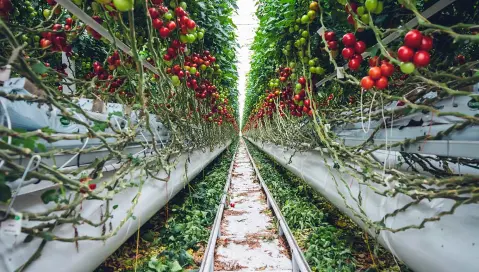Is Vertical Farming Really the Answer to Safeguarding the World's Food Security?
Is Vertical Farming Really the Answer to Safeguarding the World's Food Security?
Is Vertical Farming Really the Answer to Safeguarding the World's Food Security?
29 Juin 2021
Jack Payne
As the world searches for new ways to scale up its food supply sustainably in the face of rising populations and climate change, innovative new farming practices are hitting the headlines. Hydroponics is one such example, but a similar technique generating a lot of attention is vertical farming.
Vertical farming is being championed by some as a future panacea to the world’s food security issues, but what can the realistic impact of the practice really be? We take a look at the reasons vertical farming holds such promise, the drawbacks of the technique in its current state and assess whether it really is the future of agriculture.
What Is Vertical Farming?
Vertical farming is the practice of cultivating large amounts of produce in a small space by growing it in stacked layers. Vertically-farmed produce is typically grown in tightly climate-controlled indoor environments where conditions can be closely optimized for maximum efficiency. The growing method used in vertical farming includes techniques such as hydroponics (growing the produce in water) and aeroponics (growing the produce in nutrient-enriched air or mist).
Given the versatility of vertical farming, the technique can be implemented in almost any indoor environment, from purpose-built “factories” to reused shipping containers. All that is needed is the facilities to enrich crops with the nutrients they need, a climate controlled environment and enough LED lights to cover each layer of produce.
What Are the Benefits of Vertical Farming for Food Production?
The concept of vertical farming is a simple one, and now that the technology is in place to grow high-quality produce in such conditions, the market is growing rapidly. In 2018, the vertical farming market was valued at $2.23 billion globally but this is expected to rise to $12.77 billion by 2026.
There are a number of key advantages of farming produce in vertical, climate-controlled conditions when it comes to efficient food production.
High Yield Per Square Meter
Vertically-farmed produce can have a significantly higher yield per square meter than its conventionally grown equivalents. This is unsurprising given the nature of the practice but the numbers are worth focusing on. Research suggests the yield of lettuce per square meter of ground space is:
3.9kg when grown in an open field
41kg when grown in a greenhouse
100kg when farmed vertically
The benefits of this superiority are clear. Vertical farming essentially eliminates the need for vast fields of arable land, and this flexibility in where crop farming is possible and the amount of space required will be crucial to increasing production levels at the required pace. The technique also allows for crops to be produced all year round at a high yield given the climate-controlled conditions.
The Ability to Grow Produce Closer to Population Centers
Vertical farming also gives us far more control over where farms are situated. Locations with acres of suitable land and the right climatic conditions have typically been the only places where produce can be grown on a mass scale, but they aren’t best situated from a strategic perspective. As more of the global population migrates from the countryside to the cities, growing crops closer to these large population centers is becoming more and more important.
The practice of vertical farming is equally as useful for populations in remote locations, who have typically relied on long and sensitive supply chains to deliver their food.
Sustainable Consumption of Resources
Vertical farming also requires a fraction of the resources of open field farming, with the water savings that can be made the most pertinent factor. Returning to the example of lettuce farming, it’s estimated that growing 1 kg of lettuce requires an average water allocation of:
250 liters when grown in an open field
20 liters when grown in a greenhouse
1 liter when farmed vertically
In a world where water shortages are becoming more common, reducing the amount required for farming is a key challenge for agriculture. Vertical farming also removes the need for harmful chemicals and pesticides that account for a large proportion of the world’s water pollution.
Shrinking Supply Chains
By bringing crop production closer to the people who consume them, fresh produce supply chains can be shortened. Vertical farming offers a number of benefits in this regard, including:
Increased freshness of produce
Decreasing reliance on importing produce
Cutting food miles to reduce the environmental impact of transporting produce
Eliminating “food deserts” (areas with limited access to fresh and nutritious food)
Why Vertical Farming Is Only Part of the Answer to the World’s Food Security Needs
For a practice that has been proven to deliver more produce from fewer resources, and has so much potential for the world of agriculture, vertical farming is a long way off safeguarding the world’s food security.
Importantly, the scale of vertical farming is still very small at this stage, with analysis suggesting it only occupies around 30 hectares of land worldwide. It is also currently difficult to turn a profit due to the high costs of growing. These costs are largely energy-related, with the artificial lighting and climate control systems requiring huge amounts of energy. Vertical farming uses an average of 247 kilowatt hours to produce 1kg of lettuce, compared with as few as 70kWh for greenhouse farming.
However, the increasing need for a solution to the challenge of feeding the world’s rising population means the associated costs of vertical farming are likely to come down. This is especially important if the technology is to become viable in the developing world where the issue of food security is so acute.
It remains to be seen whether or not funding from governments and private sources will be sufficient to make vertical farming a truly mainstream form of agriculture. It’s likely that vertical farming will eventually become one key tool among many others (i.e. hydroponics, crop rotation and cheaper forms of urban agriculture) when it comes to sustainably increasing food production.
With fresh produce businesses facing a future that will require them to embrace a range of new growing methods, they need to be prepared. Software solutions like enterprise resource planning (ERP) systems bring all parts of a food organization together with one source of data truth, making it easier to incorporate new technologies smoothly and efficiently. To find out how our industry-specific food and beverage solution, Aptean Food & Beverage ERP, can help your fresh produce business contact our team of food and beverage experts today.
A Thorough Adoption Process is Crucial for a Successful ERP Implementation
9 important steps for an optimal return on investment from your new ERP solution



